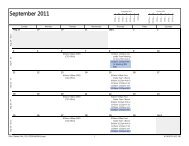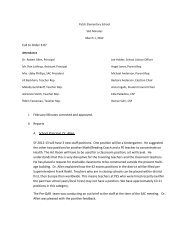Head Lice Treatment - The Options - Patch Elementary School
Head Lice Treatment - The Options - Patch Elementary School
Head Lice Treatment - The Options - Patch Elementary School
You also want an ePaper? Increase the reach of your titles
YUMPU automatically turns print PDFs into web optimized ePapers that Google loves.
<strong>Head</strong> <strong>Lice</strong> <strong>Treatment</strong> - <strong>The</strong> <strong>Options</strong><br />
<strong>Head</strong> lice are a common, controversial and frustrating problem for parents. But the controversy isn't only about how<br />
they got infected with head lice, but also revolves around how they are going to get rid of the head lice.<br />
On one side of the debate are the people who believe that head lice have developed resistance to regular lice<br />
treatments, so that they no longer work. Other experts believe that lice resistance is not a big problem, and head lice<br />
treatment failures are because parents don't remove the nits or that the child was misdiagnosed in the first place.<br />
<strong>Head</strong> lice treatments should only be used when an infestation has been confirmed by the presence of a live moving<br />
louse.<br />
<strong>Head</strong> <strong>Lice</strong><br />
Once a child gets head lice, the mature or adult head lice can lay up to 10 eggs or nits each day. <strong>The</strong>se nits, or lice<br />
eggs, hatch in about 7 to 12 days. Baby lice or nymphs are about the size of a pinhead when they hatch, and quickly<br />
mature into adult lice in about a 9 to 12 days.<br />
In just a few days, adult lice are ready mate, starting this lice life cycle all over again during their 3 to 4 week lifespan.<br />
<strong>Head</strong> <strong>Lice</strong> <strong>Treatment</strong>s<br />
<strong>The</strong> main treatments for head lice usually involve using a head lice shampoo, like Rid or Nix, and then remove nits with<br />
a lice comb. Be sure to follow the manufacturer's instructions for whatever products you choose to use, which typically<br />
includes a second treatment 7 to 10 days after the first head lice treatment.<br />
You should also check other family members to make sure that they don't have head lice too, although the AAP<br />
recommends that 'those with live lice or nits within 1 cm of the scalp should be treated.'<br />
For light infestations or if you are uncomfortable using an anti-lice shampoo, you can try to simply remove the live lice<br />
and nits manually.<br />
As there are often a lot of nits on a child and they can be hard to find and remove, you may continue to find nits for<br />
days after treatment. This doesn't mean that the treatment didn't work. If you continue to find live lice or new nits close<br />
to your child's scalp after treating with a anti-lice shampoo, then that likely does mean that it didn't work or your<br />
child was reinfected.<br />
Also be sure to wash your child's clothing and bedding in hot water and vacuum to remove lice and nits from furniture,<br />
carpets, stuffed animals, car seats, etc. According to the American Academy of Pediatrics, you really only have to<br />
clean "items that have been in contact with the head of the person with infestation in the 24 to 48 hours before<br />
treatment," and not everything in your house though. And you can put anything that you can't wash in a large plastic<br />
bag for a few weeks if you are really concerned that it is infested, although this is rarely necessary.<br />
<strong>Head</strong> <strong>Lice</strong> <strong>Treatment</strong>s - What You Need To Know<br />
Don't Panic About <strong>Head</strong> <strong>Lice</strong> - Unfortunately, the first reaction for many parents in dealing with head lice is to panic.<br />
Panicking is not going to kill the head lice though and will likely lead to over-treatment and anxiety in your child who<br />
may be concerned that they have "bugs" in their hair.<br />
Nits hatch in 7 to 10 days and develop into an adult in another 7 to 10 days which can then lay more eggs. So it is<br />
important to remove all of the nits to break this cycle. Also, since anti-lice shampoos don't usually kill nits, you have to<br />
usually retreat the child in 7 to 10 days to kill any newly hatched head lice. Many experts now recommend doing your<br />
second head lice treatment on day 9 though.<br />
Children are often misdiagnosed with head lice because they have hair casts that resemble nits, or they have dead or<br />
empty nits that are far away from the scalp. If you think your child has lice but you don't actually see any live head lice,<br />
see your pediatrician to confirm the diagnosis.
Be careful before trying 'alternative' treatments, like mayonaise, vaseline, olive oil or Tea tree oil. Although they are<br />
'natural' treatments, they are untested, and products like mayonaise can be hard to get out of a child's hair<br />
(dishwashing liquid is supposed to make it easier though).<br />
Alternative medications for resistant lice can include Ovide (malathion, an insecticide) and Lindane. Although not<br />
approved by the FDA as lice treatments, Elimite, a stronger version of Nix which is usually used to treat scabies,<br />
Crotamiton (Eurax), Ivermectim, and the antibiotic Bactrim (which kills symbiotic bacteria inside the lice), are<br />
sometimes used to treat resistant lice.<br />
Ulesfia (Benzyl Alcohol Lotion 5%) is approved to treat children over six months of age with head lice. Unlike other<br />
head lice shampoos which are mostly pesticides, Ulesfia is a water-soluble gel that works to suffocate head lice.<br />
<strong>The</strong> AAP now advises that 'no healthy child should be excluded from or allowed to miss school time because of head<br />
lice' and of course, they are still against no-nit policies that keep kids out of school because they simply have nits in<br />
their hair.<br />
When your child comes home from school with lice, the first thing you'll want to know is what the most effective and<br />
least harmful head lice treatment options are. While your first inclination may be to buy the most toxic lice shampoo on<br />
the market, this is a dangerous option that can actually make the problem worse. <strong>The</strong> fact of the matter is, the best<br />
way to get rid of head lice is to manually remove head lice the old-fashioned way: manually<br />
<strong>The</strong>re is a wide range of treatment options available for head lice infestations (or pediculosis). It is important to<br />
educate yourself about the pros and cons of each alternative before making a head lice treatment decision.<br />
Over the counter medications-Our Pharmacy<br />
Over the counter medications (OTC) are available without a prescription. <strong>The</strong>se products contain either pyrethrins or<br />
permethrins. Pyrethrins should not be used by persons who are allergic to chrysanthemums or ragweed. Permethrin<br />
should never be used on children under 2.<br />
Prescription-strength anti-lice treatments<br />
Most people assume that anything that a prescription anti-lice treatment is safer and more effective than other<br />
treatments. This is not always the case. Typically, prescriptions will contain Malathion lotion or Lindane shampoo.<br />
Malathion should not be used by children under the age of 6, can irritate skin, and should not make contact with eyes.<br />
It is also flammable, so no heat sources should be used when applying. Lindane is not recommended as a first-line<br />
therapy. According to the CDC, "Overuse, misuse, or accidentally swallowing lindane can be toxic to the brain and<br />
other parts of the nervous system; its use should be restricted to patients who have failed treatment with or cannot<br />
tolerate other medications that pose less risk.<br />
Medical Devices (in Europe, you will be able to identify these as they will have a CE mark on the packaging)<br />
often use mechanical rather than chemical methods to kill the lice. <strong>Treatment</strong>s that contain dimethicone, a<br />
silicon type substance, coat the lice preventing them releasing water and effectively drown them. <strong>Treatment</strong>s<br />
containing Cyclomethicone dissolve the waxy exoskeleton of the lice killing them through dehydration.<br />
Why shampoos are one possible and partial solution<br />
Over-the-counter shampoos containing permethrin may kill live lice, but not always. Strains of permethrin-resistant<br />
lice are becoming more and more common. Children under the age of two, people with asthma, allergies, seizures,<br />
pregnant and breastfeeding women should consult their physician before applying these shampoos.<br />
<strong>The</strong> real natural solution<br />
<strong>The</strong> most effective means of control, no matter what type of chemical control you might employ, requires wet-combing<br />
(manual removal), requiring someone to take your child's hair, one small section at time, and inspect for the presence<br />
of adult lice or nits. <strong>The</strong> best way to do this is to use a high-quality, metal head lice comb to pull the adults and nits off<br />
each hair strand, not that plastic nit-comb that comes with many of the OTC shampoos.















